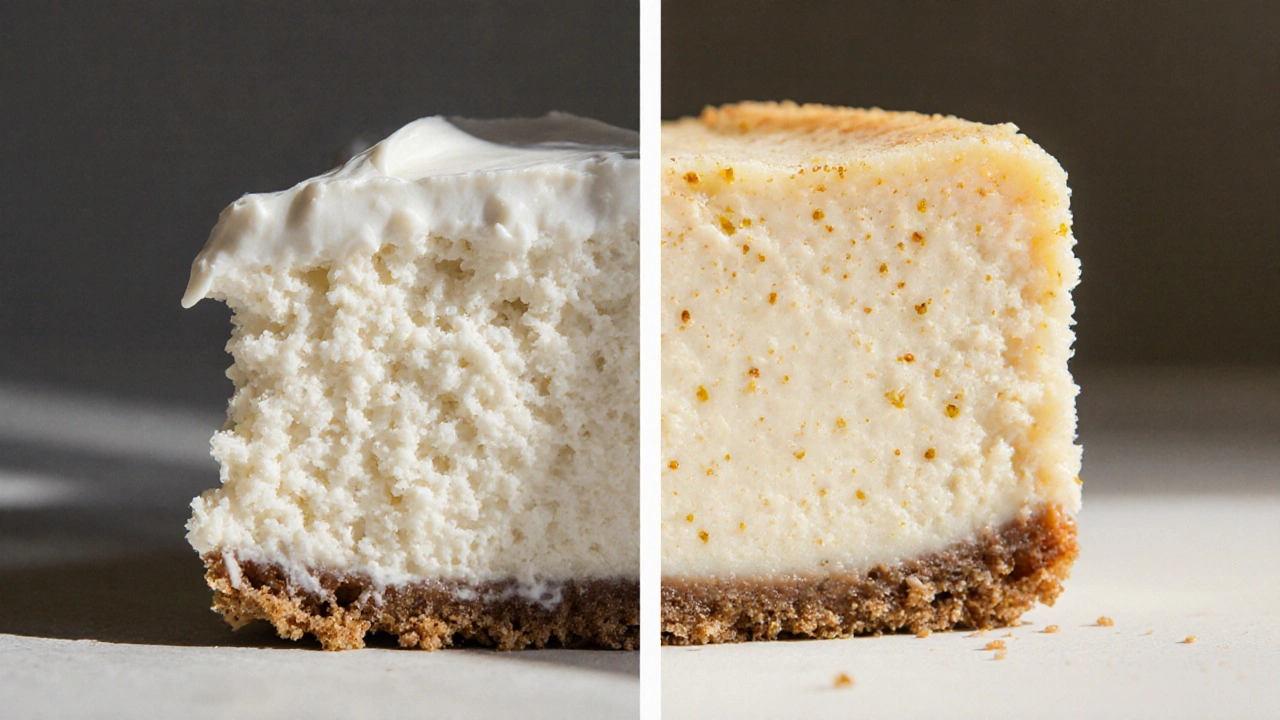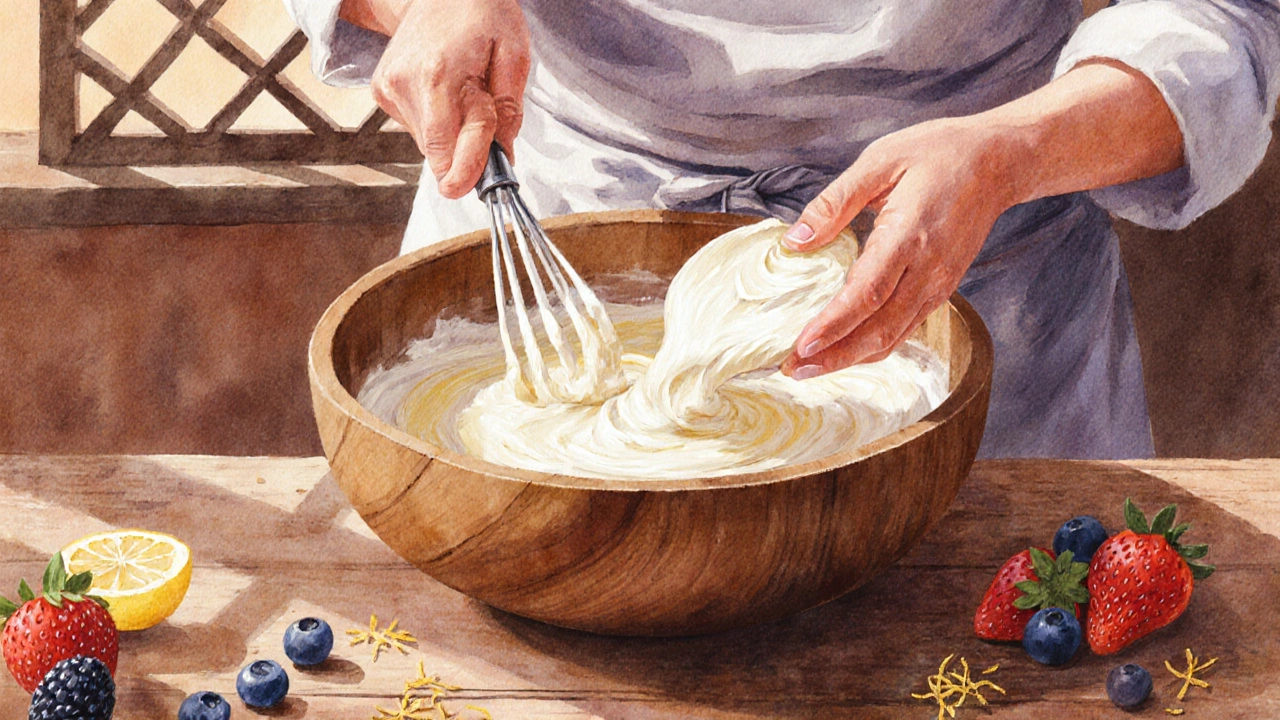Cheesecake Cream Selector
Heavy Whipping Cream
Higher fat (36-40%), creates silky, light texture. Perfect for melt-in-your-mouth cheesecakes.
Sour Cream
Moderate fat (18-20%) with acidity, adds tang and stability. Great for firm slices with balanced flavor.
Recommended Cream Type
Cheesecake is a rich, baked dessert made from cream cheese, sugar, eggs, and often a hint of vanilla or fruit. When the base is set, the next big decision is which dairy fat to add for that silky mouthfeel. Do you reach for heavy whipping cream or sour cream? Both bring unique chemistry, but they don’t behave the same way in a batter.
Why the Cream Choice Matters
The right cream affects three core qualities of a cheesecake: texture, flavor balance, and stability during baking. A creamy, smooth crumb comes from the interplay of fat, water, and acid. Swap one ingredient for the other, and you’ll notice a shift-sometimes subtle, sometimes dramatic.
Defining the Players
- Heavy whipping cream is a dairy product containing at least 36% milk fat, known for its ability to hold air when whisked.
- Sour cream is a cultured dairy product with about 18-20% fat and a characteristic tang from lactic acid bacteria.
- Cream cheese is the primary cheese used in cheesecake, typically 33% fat and very mild in flavor.
- Fat content is the percentage of milk fat in a dairy product, influencing richness and melt behavior.
- Acidity is the measure of hydrogen ions, often expressed as pH, that affects protein coagulation and flavor.
- Texture is the perceived smoothness or graininess of the finished cheesecake, driven by moisture and fat distribution.
- Baking temperature is the oven heat during the cooking phase, which can amplify or mellow the impact of added creams.
Side‑by‑Side Comparison
| Attribute | Heavy Whipping Cream | Sour Cream |
|---|---|---|
| Fat content | 36-40% | 18-20% |
| Acidity (pH) | ~6.5 (neutral) | ~4.5 (tangy) |
| Moisture % | ≈55% | ≈80% |
| Flavor contribution | Rich, buttery, buttery‑sweet | Slightly sour, depth‑enhancing |
| Texture impact | Silky, light, helps create a custard‑like crumb | Denser, creamier, adds a subtle graininess if over‑mixed |
| Best use case | When you want a lofty, melt‑in‑your‑mouth bite | When you crave a tang that cuts richness and stabilises the batter |
How Fat and Acid Shape the Final Bite
Fat does more than make a dessert feel luxurious. In a baked cheesecake, it coats the protein strands of cream cheese, preventing them from forming a tight, rubbery network. Heavy whipping cream, with its higher fat, creates that coating more effectively, leading to a softer, more “melt‑in‑the‑mouth” sensation.
Acidity, on the other hand, works like a culinary glue. Sour cream’s lactic acid lowers the pH, encouraging the cream cheese proteins to set earlier. This early set can prevent over‑expansion of air bubbles, which is why sour cream often yields a firmer slice that holds its shape when cut. However, too much acid can make the crumb overly dense and introduce a noticeable sour note.

Practical Baking Guidelines
- Measure precisely. A typical 9‑inch cheesecake calls for 1 cup of heavy cream or 1 cup of sour cream. Swapping one for the other without adjusting other liquids can throw off the moisture balance.
- Temper the cream. Bring whichever cream you’re using to room temperature before mixing. Cold cream can cause the batter to seize, trapping air pockets and creating cracks.
- Mix gently. Over‑whipping heavy cream introduces excess air, which expands in the oven and can cause cracks. With sour cream, a brief fold is enough; vigorous beating can break down its stabilising proteins.
- Bake low and slow. Most cheesecakes thrive at 300°F (150°C) for 45‑60 minutes. This gentle heat gives the fats time to melt uniformly and the acids time to set the structure without curdling.
- Cool gradually. After the oven, let the cheesecake sit in the turned‑off oven for 15 minutes, then move to a wire rack. The slow cooling lets the fats re‑emulsify, preserving a smooth mouthfeel.
When to Choose Heavy Whipping Cream
If you’re aiming for a light, airy slice that feels almost like a mousse, heavy whipping cream is your go‑to. It’s especially useful in:
- Classic New York‑style cheesecakes where richness is prized.
- Recipes that call for a whipped topping folded into the batter for extra loft.
- Seasonal flavors that already have a sweet profile, such as caramel or chocolate, where you don’t want extra tang.
Because of its higher fat, heavy cream also tolerates a bit more sugar without turning grainy, which is handy when you’re sweetening a fruit‑laden version.
When Sour Cream Takes the Lead
Sour cream shines when you need a balancing acidity or a sturdier slice. Ideal scenarios include:
- Cheesecakes with a fruit compote (raspberry, lemon) where a hint of sour cuts through the fruit’s natural tartness.
- Lower‑fat versions where you replace part of the cream cheese with sour cream to keep calories down while retaining creaminess.
- Recipes that incorporate a caramelized topping; the acidity prevents the top from becoming overly sweet.
Mix‑and‑Match: The Hybrid Approach
Many bakers swear by a 50/50 split-half heavy whipping cream, half sour cream. This combo delivers the best of both worlds: the buttery silk of the cream and the stabilising tang of the sour. If you try it, keep the total liquid volume the same as the single‑cream version, and watch the batter’s consistency; it should be pourable but not runny.

Health‑Conscious Considerations
From a nutrition standpoint, heavy whipping cream packs about 340 calories per cup, while sour cream is roughly 240 calories. Both are high in saturated fat, but sour cream’s lower fat content can be a modest advantage if you’re watching intake. However, the richer mouthfeel of heavy cream often means you need less of it to achieve the same satisfaction, which can offset the calorie difference.
Common Mistakes and How to Fix Them
- Using low‑fat “light” versions. Light sour cream often contains starches that can make the cheesecake gummy.
- Over‑mixing. Especially with heavy cream, this incorporates too much air, leading to cracks.
- Skipping the temper step. Cold cream can cause the batter to separate, resulting in a grainy texture.
- Ignoring pH. If the recipe already includes other acidic ingredients (like lemon juice), you may want to reduce the sour cream amount.
Key Takeaways
- Heavy whipping cream provides higher fat, yielding a lighter, silkier texture.
- Sour cream adds acidity, giving a firmer slice and a subtle tang.
- Choose based on the desired mouthfeel and flavor balance; a 50/50 blend works for most recipes.
- Maintain proper temperature, mix gently, and bake low for best results.
Frequently Asked Questions
Can I replace sour cream with Greek yogurt?
Greek yogurt has a similar tang but lower fat, which may make the cheesecake slightly less creamy. To keep the texture close, add a tablespoon of melted butter for every cup of yogurt you use.
Is it okay to use whipped topping instead of heavy cream?
Whipped topping contains stabilisers and sugars that can affect the bake. It may prevent the batter from setting properly, resulting in a wobblier slice. Stick to real heavy cream for reliable results.
What if I only have low‑fat cream?
Low‑fat cream can make the cheesecake dry. Counterbalance by adding an extra egg yolk or a tablespoon of melted butter to boost richness.
How long can a cheesecake made with sour cream be stored?
Refrigerated, it stays fresh for up to 5 days. For longer storage, wrap tightly and freeze; it retains texture for about a month.
Do I need to brush the pan when using heavy cream?
A water bath (bain‑marie) does the heavy lifting. Greasing the pan is optional, but a light coating of butter helps release the cheesecake cleanly.